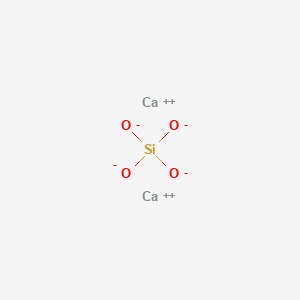



1. 1344-95-2
2. Micro-cel
3. Dicalcium;silicate
4. Calcium Silicate [nf]
5. Calsil
6. Calcium Silicate (nf)
7. Cs Lafarge
8. Toyofine A
9. Florite R
10. Microcal Et
11. Starlex L
12. Calflo E
13. Silmos T
14. Silene Ef
15. Micro-cel A
16. Micro-cel B
17. Micro-cel C
18. Micro-cel E
19. Micro-cel T
20. Promaxon P60
21. Calcium Monosilicate
22. Calcium Polysilicate
23. Stabinex Nw 7ps
24. Marimet 45
25. Micro-cel T26
26. Micro-cel T38
27. Micro-cel T41
28. Microcal 160
29. Calcium Hydrosilicate
30. Silicic Acid Calcium Salt
31. Hsdb 705
32. Einecs 215-710-8
33. Sw 400
34. Calcium Silicate, Synthetic Nonfibrous
35. Calcium Silicate, Synthetic
36. Unii-s4255p4g5m
37. Dicalcium Orthosilicate
38. Ec 215-710-8
39. Dtxsid5049570
40. Nsc 57629
41. Akos015915657
42. D03309
43. Q416365
44. 39433-03-9
| Molecular Weight | 172.24 g/mol |
|---|---|
| Molecular Formula | Ca2O4Si |
| Hydrogen Bond Donor Count | 0 |
| Hydrogen Bond Acceptor Count | 4 |
| Rotatable Bond Count | 0 |
| Exact Mass | 171.8817667 g/mol |
| Monoisotopic Mass | 171.8817667 g/mol |
| Topological Polar Surface Area | 92.2 Ų |
| Heavy Atom Count | 7 |
| Formal Charge | 0 |
| Complexity | 19.1 |
| Isotope Atom Count | 0 |
| Defined Atom Stereocenter Count | 0 |
| Undefined Atom Stereocenter Count | 0 |
| Defined Bond Stereocenter Count | 0 |
| Undefined Bond Stereocenter Count | 0 |
| Covalently Bonded Unit Count | 3 |
Calcium Silicate is listed in the OTC Active Ingredient Status Report as an external analgesic and skin protectant.
Elmore AR; Cosmetic Ingredient Review Expert Panel; J Am Coll Toxicol 22 (Suppl. 1): 37-102 (2003)
MEDICATION (VET): ... /IT/ HAS ANTACID & ADSORBENT PROPERTIES SIMILAR TO MAGNESIUM SILICATES.
Rossoff, I.S. Handbook of Veterinary Drugs. New York: Springer Publishing Company, 1974., p. 72
The substance can be absorbed into the body by inhalation.
International Program on Chemical Safety/Commission of the European Communities; International Chemical Safety Card on Calcium silicate (May 2001). Available from, as of May 20, 2010: https://www.inchem.org/pages/icsc.html
The biodurability of various glass fibers, rockwool, and ceramic fibers was examined in rat lungs and compared with natural mineral fibers ... Sized fractions of fibers were instilled intratracheally into Wistar rats ... The half-time of fiber elimination from the lung ranges from about 10 days for wollastonite to more than 300 days for crocidolite. The biodurability of man-made vitreous fibers (MMVF) is between these values and is dependent on the chemical composition of the fibers and the diameter and length distribution ...
PMID:7882923 Full text: https://www.ncbi.nlm.nih.gov/pmc/articles/PMC1567280 Muhle H et al; Environ Health Perspect 102 Suppl 5: 163-8 (1994).
Calcium silicate has been considered as a possible replacement for asbestos due to its heat and fire resistance. The cytotoxic and genotoxic potential of calcium silicate using peripheral human blood lymphocytes is described. Calcium silicates at concn of 10 and 100 ug/ml significantly increased the frequencies of chromosomal aberrations and sister chromatid exchanges. The increases in chromosomal aberrations and sister chromatid exchanges were dose-dependent, though not linearly. A significant decrease in the proliferation rate index was observed with increased dose of calcium silicates. The induction of chromatid type aberrations indicates that the clastogenic activity of calcium silicate is S-phase-dependent.
PMID:7683767 Aslam M, Rahman Q; Mutat Res 300 (1): 45-8 (1993)